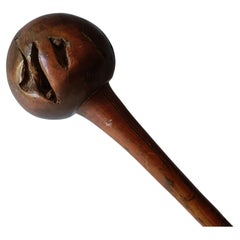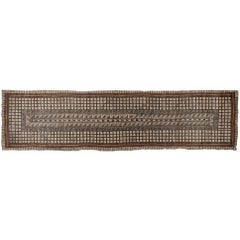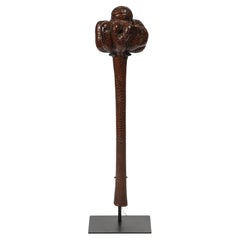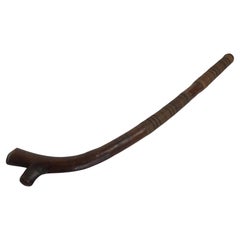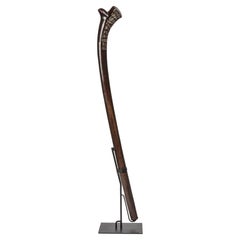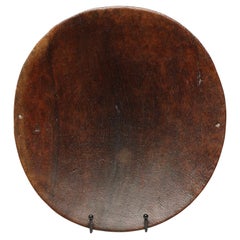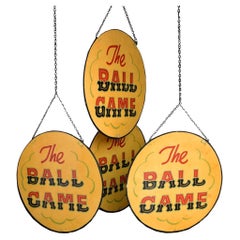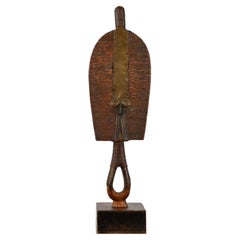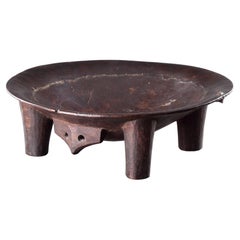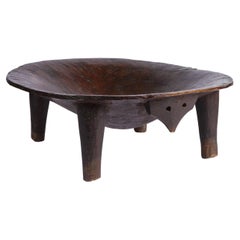Fijian Tribal Art
to
1
5
2
7
2
2
3
1
1
1
1
6
4
1
1
1
11
759
623
362
193
7
7
7
Place of Origin: Fijian
Fiji Ula Club Polynesian war club Tribal Oceanic Antiques
Located in London, GB
Fiji Ula Club Polynesian war club Tribal Oceanic
A good antique Fiji Ula throwing club
With naturally occurring root fissures on the ball head
Good condition with minor age cra...
Category
19th Century Antique Fijian Tribal Art
Materials
Hardwood
Mid-20th Century Tribal Tapa Cloth, Fiji
Located in Point Richmond, CA
Tapa cloth made from mulberry fiber with natural pigments, Fiji, mid-20th century.
Category
Mid-20th Century Tribal Fijian Tribal Art
Materials
Natural Fiber
18th Century Polynesian Hardwood Ula Tavatava or Throwing War Club from Fiji
Located in Amsterdam, NL
A Polynesian hardwood Ula tavatava or throwing war club
Fiji, probably 18th century
All-over decorated in incised pattern, the bulbous top seems to have a stone grown into it.
H. 42 cm
Including museum-quality powder-coated stand.
Provenance:
Private collection, France
Polynesian culture is traditionally a culture of power and prestige, and there was a fine line between battle and ceremony. Warrior people par excellence, the Fijians had at their disposal a large panoply of weapons, each for a specific use.
The elegant Gata are called gun-sticks by Europeans due to the recognizable form. However, they are designed after a snake, gata in Fijian language. The Ula throwing clubs...
Category
18th Century Antique Fijian Tribal Art
Materials
Hardwood
A Polynesian war-club or 'Gata waka'
Located in Amsterdam, NL
Fiji, probably early 20th century
Polynesian culture is traditionally a culture of power and prestige, and there was a fine line between battle and ceremony. Warrior people par exce...
Category
Early 20th Century Fijian Tribal Art
Materials
Hardwood
18th Century Polynesian Ironwood Gata Waka or War Club from Fiji
Located in Amsterdam, NL
A Polynesian ironwood Gata waka or war club
Fiji, probably 18th century or earlier
Measures: Height. 97 cm
Including museum-quality powder-coated stand.
Provenance:
Private collection, France
Polynesian culture is traditionally a culture of power and prestige, and there was a fine line between battle and ceremony. Warrior people par excellence, the Fijians had at their disposal a large panoply of weapons, each for a specific use.
The elegant Gata are called gun-sticks by Europeans due to the recognizable form. However, they are designed after a snake, gata in Fijian language. The Ula throwing clubs...
Category
18th Century Antique Fijian Tribal Art
Materials
Hardwood
Ancient Fiji Islands Flat Serving Bowl or Platter 19th century Polynesia
Located in Point Richmond, CA
Ancient Fiji Islands Flat Serving Bowl or Platter 19th century, made of very dense hardwood with deep patina, and expected wear on bottom. Two small opposing holes for suspension.
B...
Category
Late 19th Century Tribal Antique Fijian Tribal Art
Materials
Wood
$2,000 Sale Price
20% Off
Ironwood Root Carved War Club
Located in London, GB
Gunstock shaped war club ‘Sali’. Ironwood root carved with traditional motifs. An excellent example, mounted on a custom stand in patinated bronze.
Measure...
Category
1980s Vintage Fijian Tribal Art
Materials
Iron
Related Items
Mid-20th century double sided English Fairground Sign
Located in London, GB
Mid-20th century double sided English Fairground Sign
We are proud to offer a single double-sided hand painted mid-20th century English fairground sign. We currently have a rare coll...
Category
1950s Mid-Century Modern Vintage Fijian Tribal Art
Materials
Wood
African Tribal Statue Osseyba or Reliquary Figure Kota Mohongwe Peoples Art
Located in Miami, FL
A fantastically hand-crafted piece by the Kota (or Bakota) tribe who are located in the northeastern region of Gabon. This figure, which is a Mahongwe reliquary figure as exhibited with its truncated almond-shaped face, is made of wound copper, hammered brass and wood. Reliquary figures were used as guardians to protect the revered bones of venerated family ancestors and leaders and ward off unwanted spirits. These figures are meant to embody intense powers and were also commonly used in communal rites and ritual performances.
This particular piece came from an American collector who traveled the African continent and collected African artifacts for over 50 years. This piece has a beautiful, organically aged patina acquired naturally over time and use. It is mounted on a custom wooden display stand. We believe it dates back to the early to mid-1900s but could be older. We are listing as 20th century because we did not have it appraised.
This African Tribal Statue Osseyba or Reliquary Figure Kota (Bakota) Mohongwe Peoples decorative art would clearly stand out as part of a collection or by itself in any setting. Truly unique, eye-catching and engaging.
Dimensions on stand: 25 3/4" High, 7" Wide, 5 1/2" Deep
Kota Reliquary...
Category
Early 20th Century Tribal Fijian Tribal Art
Materials
Brass, Copper
$3,200
H 25.75 in W 7 in D 5.5 in
Vintage Pal Kepenyes Bronze/Brass Necklace, 20th Century
By Pal Kepenyes
Located in Point Richmond, CA
Vintage Pal Kepenyes bronze/brass necklace, 20th century.
This Hungarian born artist worked in Mexico for decades, known for free-form sculptural jewelry...
Category
20th Century Modern Fijian Tribal Art
Materials
Brass, Bronze
$760 Sale Price
20% Off
H 19.5 in W 3.5 in D 0.5 in
A Rare Papua New Guinea Kukukuku 'Pineapple' Stone War Club, Eastern Highlands
Located in Ottawa, Ontario
This rare antique Kukukuku (pronounced "cookah-cookah") war club is from the remote Morobe Province located within the Eastern Highlands of Papua New Guinea.
The head is carved from...
Category
Early 20th Century Tribal Fijian Tribal Art
Materials
Stone
$2,200
H 4.5 in W 26 in D 4.5 in
Antique Maori hard wood stick staff Tiki design Oceanic Polynesian
Located in London, GB
Antique Maori hard wood stick staff Tiki design Oceanic Polynesian
A Finely carved antique Maori hard wood stick
A Maori hard wood staff or walking ...
Category
Early 20th Century Fijian Tribal Art
Materials
Hardwood
$654
H 36.23 in W 1.97 in D 1.19 in
Old Australian Aboriginal Peoples Throwing Club
Located in South Burlington, VT
A monumental Australian aboriginal throwing club, crafted from a very hard wood and it dates to the early 20th century.
Incised longitudinal fluted design with a pitch coated handle.
Condition: Very good condition. Display base not included.
Dimensions: 26.5 inches in length.
Lifetime guarantee of authenticity: All of our works of art come with our lifetime authenticity guarantee. Red base not included.
History:
The throwing stick...
Category
Early 20th Century Fijian Tribal Art
Materials
Wood
Folk Style Filipino Hanging Talisman Or Outdoor Chandelier
Located in Prato, Tuscany
We kindly invite you to read the full description below, as it contains detailed technical and historical information to ensure the authenticity and value of our pieces.
An original ...
Category
Late 20th Century Folk Art Fijian Tribal Art
Materials
Metal
Tulips, Arabesques and Turbans, Decorative Arts from the Ottoman Empire
Located in valatie, NY
Tulips, Arabesques and Turbans: Decorative Arts from the Ottoman Empire by Yanni Petsopoulos. Abbeville Press, 1982. First Edition hardcover no dust jacket. The author analyzes the p...
Category
1980s Vintage Fijian Tribal Art
Materials
Paper
$79
H 11.25 in W 8.5 in D 0.5 in
Late 19th Century Silk Ikat Uzbekistan Tribal Weaving
Located in New York, NY
Gorgeous handwoven silk Ikat weaving in rich magenta, gold and purple color, circa late 19th-early 20th century, Uzbekistan, Central Asia, on the ancient...
Category
Late 19th Century Tribal Antique Fijian Tribal Art
Materials
Silk
Mid-20th Century Fante Asafo Flag, Ghana
Located in New York, NY
A large and graphically stunning asafo flag.
Fante flags represent the merger of two cultural traditions, the Akan tradition of combining proverbs with ...
Category
Mid-20th Century Fijian Tribal Art
African Vintage Shield, Tribal Wall Art, SONGYE SHIELD, Congo, Mid 20th Century
Located in Odense, DK
The Songye Shield is a striking example of African tribal art from the Congo, dating back to the mid-20th century. This shield, traditionally used by the Songye people for protection...
Category
Late 19th Century Primitive Antique Fijian Tribal Art
Materials
Wood
$2,450
H 62.21 in W 15.75 in D 0.79 in
Late 19th Century War Club, Samoa
Located in Point Richmond, CA
Late 19th Century Fa’alautalinga War Club, Samoa
A short cylindrical handle flares and flattens into a paddle form tapering to an edge, with a raised medial ridge on both sides. Fin...
Category
Late 19th Century Tribal Antique Fijian Tribal Art
Materials
Wood
Previously Available Items
A Fine Fijian Chief’s ‘Yaqona’ or Kava Bowl
Located in London, GB
A Fine Fijian Chief’s ‘Yaqona’ or Kava Bowl
Carved of vesi wood with traces of old residue deposits, with old ‘fibre’ tribal repair
Wood, fibre
Fiji
19th Century
Size: 14cm high,...
Category
19th Century Antique Fijian Tribal Art
Materials
Natural Fiber, Wood
Fine and Large Polynesian Kava Bowl or Tanoa from Fiji, Early 19th Century
Located in Amsterdam, NL
A fine and large Fijian Kava bowl or tanoa
Polynesia, early 19th century
Overall with a very attractive dark brown patina and traces of usage.
Diam....
Category
Early 19th Century Antique Fijian Tribal Art
Materials
Hardwood
18th Century Polynesian Hardwood Ula Tavatava or Throwing War Club from Fiji
Located in Amsterdam, NL
A Polynesian hardwood Ula tavatava or throwing war club
Fiji, probably 18th century
The top of the shaft decorated with a dotted pattern all around (possibly kill marks).
Measures: Height. 44 cm
Including museum-quality powder-coated stand.
Provenance:
Private collection, France
Polynesian culture is traditionally a culture of power and prestige, and there was a fine line between battle and ceremony. Warrior people par excellence, the Fijians had at their disposal a large panoply of weapons, each for a specific use.
The elegant Gata are called gun-sticks by Europeans due to the recognizable form. However, they are designed after a snake, gata in Fijian language. The Ula throwing clubs...
Category
18th Century Antique Fijian Tribal Art
Materials
Hardwood
H 17.33 in W 5.91 in D 5.91 in
18th Century Polynesian Hardwood Totokia, War Club or Battle Hammer from Fiji
Located in Amsterdam, NL
A Polynesian hardwood Totokia, war club or battle hammer
Fiji, probably 18th century or earlier
Measures: Height. 83 cm
Including museum-quality powder-coated stand.
Provenance:
Private collection, France
The curve in the Totokia club, used for obvious reasons, is made by carving into a living branch and bending it, closing the gaps, which will grow together again over the years. Weapons carried by the Tusken Raiders of Tatooine in George Lucas' Star Wars were inspired by the Totokia.
Polynesian culture is traditionally a culture of power and prestige, and there was a fine line between battle and ceremony. Warrior people par excellence, the Fijians had at their disposal a large panoply of weapons, each for a specific use.
The elegant Gata are called gun-sticks by Europeans due to the recognizable form. However, they are designed after a snake, gata in Fijian language. The Ula throwing clubs...
Category
18th Century Antique Fijian Tribal Art
Materials
Hardwood
H 32.68 in W 7.88 in D 7.88 in
Fijian War Club, Ula Tavatava
Located in Stockholm, SE
A Ula Fijian war club, Ula Tavatava, shell carved handle.
Fiji, 19th century.
Category
19th Century Primitive Antique Fijian Tribal Art
Materials
Wood
